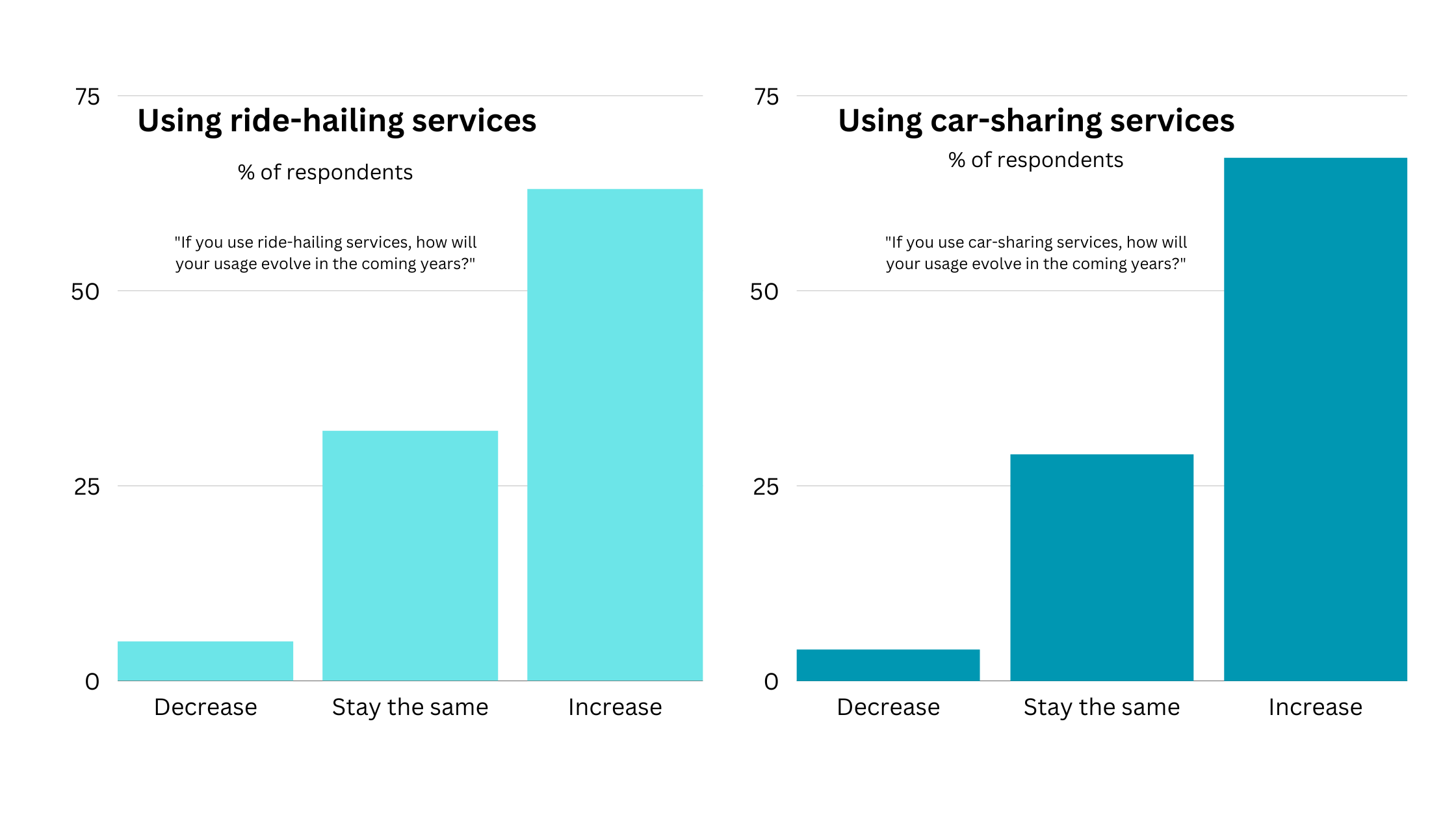
Navigation
Contact Information
Toronto – 320 Front St W Suite 1600, M5V 3B6
Halifax – 2570 Agricola St, B3K 4C6
Email: info@timespacemedia.com
Phone: 902-429-8463
Subscribe to our insights newsletter

As our society becomes increasingly focused on sustainability and cost-effectiveness, car-sharing and ride-hailing services have become more popular than ever. These services allow individuals and businesses to rent or share vehicles on an as-needed basis, rather than owning their own car. For car dealerships, this presents a unique opportunity to market cars to a new and growing customer segment.
According to a study by Deloitte, by 2025, car-sharing services are expected to generate annual revenues of around $6 billion globally. This presents a huge opportunity for car dealerships to tap into this growing market by marketing their vehicles specifically to car-sharing and ride-hailing services.
Finding the right audience
Car-sharing and ride-hailing services have specific needs when it comes to vehicles, such as fuel efficiency, low maintenance costs, and the ability to seat multiple passengers comfortably. By understanding these needs, car dealerships can tailor their marketing efforts to highlight the features of their vehicles that cater to these specific requirements.

The most likely customers for car-sharing and ride-hailing services are individuals who live in urban areas with limited parking options, those who prefer not to own a car or cannot afford one, and people who are environmentally conscious and choose to reduce their carbon footprint by sharing rides or using alternative transportation options. Statista predicts that in the car-sharing segment “the number of users is expected to amount to 1.08m users by 2027.” Both those who will be listing a car and those who will be using them. Additionally, businesses that operate in dense urban areas may also rely on car-sharing or ride-hailing services to transport employees or deliver goods. These customer segments represent a growing market for car dealerships looking to expand their reach and increase sales.
While previously, car-sharing was primarily available through car-sharing companies like Zipcar, Communauto, and Evo, the opportunities are growing for consumers with sites like Turo, that allow individuals to list their cars for use like an Airbnb. And “about 73% of people who list at least three cars on Turo think of it as a small business and have noticed an increase in bookings since the beginning of 2021.” This changes the game for dealerships as they aren’t only selling car-share ready vehicles to companies, but individuals who may be looking for a vehicle specifically to list it like an income property or someone using it as an Uber or Lyft. This means that having conversations with your consumers is extra important in understanding that each vehicle you are selling could be multi-use.
Meeting your audience where they are
As you begin to have these kinds of conversations with customers, you’ll need to know what is important to this growing segment. Since the car you may be selling may not be for a single household but touch the lives of dozens or hundreds of individuals, the way you market will drastically change.
Flexible financing options are crucial when it comes to selling cars to individuals or businesses that are running car-sharing or ride-hailing services. Since these businesses often require multiple vehicles, it can be challenging for them to purchase cars outright. As a result, dealerships must partner with financial institutions to provide customized financing solutions that meet the needs of these businesses.
This is where the importance of flexible financing options comes into play. Dealerships can work with their financing partners to offer lease-to-own agreements or other flexible payment plans that allow businesses to acquire the necessary vehicles without having to make a significant upfront investment. By offering these financing options, dealerships can make it easier for these businesses to acquire the cars they need to operate, while also building long-term relationships with their customers.
Furthermore, flexible financing options can also make it easier for individual customers to purchase cars for use in car-sharing or ride-hailing services. Many individuals may be hesitant to make a significant financial commitment, especially if they are just starting out in the business. By offering flexible financing options, dealerships can make it easier for these individuals to acquire the cars they need, which can help them establish their business and grow over time.
Emphasizing safety and reliability is crucial for marketing cars to car-sharing and ride-hailing services. Customers who use these services often prioritize safety and reliability over other factors because they are entrusting their well-being to the vehicles they use. Car dealerships can market their cars to these services by highlighting safety features such as automatic emergency braking, lane departure warning, and blind-spot monitoring. Additionally, emphasizing reliability can help to increase customer trust in the vehicle, which is especially important for car-sharing services where the car is used by multiple people.
Another important factor for marketing cars to these services is showcasing fuel efficiency and low emissions. Car-sharing and ride-hailing services often prioritize fuel efficiency and environmental friendliness in their vehicles to reduce operating costs and minimize their impact on the environment. One shared car replaces up to about 20 personal cars, emphasizing this importance to your sustainability-focused customers will show you care about the impact they are looking to make. Dealerships can highlight the gas mileage and environmental certifications of their vehicles to appeal to these services.
In addition to safety, reliability, fuel efficiency, and low emissions, car dealerships can also market technology features to car-sharing and ride-hailing services. Navigation systems and Bluetooth connectivity can make the driving experience more convenient and enjoyable for passengers. Dealerships can showcase these features as a way to differentiate their cars from others in the market and appeal to tech-savvy customers. Overall, highlighting safety, reliability, fuel efficiency, low emissions, and technology features can help car dealerships to effectively market their cars to car-sharing and ride-hailing services.
How to engage with your audience
To engage with the audience, it’s essential to understand their needs and preferences, especially when it comes to new ventures such as car-sharing and ride-hailing services. As a dealership, creating awareness and understanding is critical to attracting potential customers.
One effective strategy is creating short and informative videos that showcase the key features of the vehicles. This could include highlighting the fuel efficiency and technology features that are essential for this market. Additionally, sharing customer testimonials and case studies that demonstrate the success of car-sharing and ride-hailing services that use the dealership’s vehicles can help build trust and credibility with potential customers.
Social media can also be an effective platform to target specific customer segments with ads that highlight the features of the vehicles that are most important to them. Hosting social media contests that encourage users to share their experiences with car-sharing or ride-hailing services can create buzz around the dealership’s vehicles and generate user-generated content that can be shared on social media.
Finally, working with social media influencers or brand ambassadors can be an excellent way to promote the dealership’s vehicles for car-sharing and ride-hailing services. These influencers can create content that showcases the benefits of the vehicles and shares their personal experiences using them for these services. By utilizing these strategies, dealership marketers can effectively engage with their audience and drive sales for car-sharing and ride-hailing services.
The role of collaboration
Partnering with car-sharing and ride-hailing services to offer exclusive deals can be an effective way for dealerships to tap into this growing market. By offering special discounts or packages for drivers who use their vehicles for these services, dealerships can increase their sales and generate brand loyalty among customers.
To take it a step further, dealerships can collaborate with these services to gain insight into customer preferences and behaviors. By understanding the needs and desires of car-sharing and ride-hailing customers, dealerships can tailor their marketing strategies and product offerings to better meet their demands.
For example, a dealership might collaborate with a ride-hailing service to analyze data on the most commonly requested vehicle types, features, and price points. Armed with this information, the dealership can then adjust their inventory and pricing strategies to better cater to this market segment. Additionally, dealerships can partner with car-sharing and ride-hailing services to conduct customer surveys and collect feedback on the vehicles and services they offer. This feedback can be used to improve future product offerings and customer experiences.
As car-sharing and ride-hailing services have become increasingly popular, presenting a unique opportunity for car dealerships to market cars to a growing customer segment. Car dealerships can tailor their marketing efforts to highlight the features of their vehicles that cater to specific requirements of car-sharing and ride-hailing services. By understanding and meeting the needs of this growing market, car dealerships can expand their reach, increase sales, and build long-term relationships with their customers.
Toronto – 320 Front St W Suite 1600, M5V 3B6
Halifax – 2570 Agricola St, B3K 4C6
Email: info@timespacemedia.com
Phone: 902-429-8463
Subscribe to our insights newsletter